Chris Baty's Blog, page 106
March 2, 2018
7 Tips for Making Your Own Luck During Camp NaNoWriMo

Camp NaNoWriMo is just around the corner! If you’re a first-time camper, welcome! You might be wondering what you should do during Camp Nano to produce a great, publish-ready book! Today, writer Christoffer Petersen shares his tips for making your own luck during Camp NaNo:
It’s never too early to go camping.
My Camp NaNo stats include two published novels, which are currently climbing the mystery thriller charts on Amazon. They have built the foundation of my writing career. Here’s how I used Camp NaNoWriMo to get my camp drafts published:
Tip #1: Make the most of the Public Cabin.Public cabins are great, and I have enjoyed supporting other campers and being supported while writing in April and July each year. It doesn’t take more than a few lines in the chat to give or ask for help. If you’re new to Camp then be sure to introduce yourself and regularly check in for updates. It’s this part of camp life that keeps you going, and gets those words on the page.
Tip #2: Create a Private Cabin.Make a note of the other campers you shared a cabin with, especially the ones who contributed to your word count with motivating comments—perhaps even a pep talk in between. Then, when the next camp comes around, be bold! Create a Private Cabin and invite the same campers, or ask to be invited. It’s important to build on that first camp session, and to establish a positive writing environment.
Tip #3: Set your own goals.Camp NaNo is great because you can set your own goals. Be sure to do that, even if you are editing a manuscript you wrote during Nanowrimo in November. I’ve done this several times, and left Camp with a finished first draft ready for others to read and edit.
Tip #4: Get more eyes on your work.Now that your draft is finished, it’s important to get more eyes on it, and even better to have an editor go through your work. You can pay for the services of an editor, but if you’re lucky, you’ll know an editor that you trust. There are other ways to catch classic and repetitive mistakes by using some of the brilliant editing software programmes available. However, it’s still important to have humans read and edit your story. And, no, your mum is not your best friend when it comes to editing—if possible, try to recruit readers who will be honest, but constructive.
Tip #5: Set deadlines and stick to them.Deadlines are really important if you want to get your work published. Without them, you can continue working on the same project for the rest of your life. Deadlines create a sense of urgency, and a sense of importance. You should take pride in your work, and be proud of the effort required to write your story. Setting a deadline for publication will ensure that your project has a finish line, and people have the chance to read your story.
Tip #6: Trust your readers and self publish.I’m just going to say it: self publish. If you have written a bestseller, your readers—who are your best critics—will let you know. If you haven’t, they will let you know. The days of traditional publishing as the only way to be recognized as an author are gone. You can choose that route, and you might be lucky, or you can self publish and make your own luck.
Don’t settle for second best or a half-edited draft. Do your best work, and give it your best shot, and then do it all over again.
Tip #7: Go camping again.It doesn’t matter if you choose to go back to Camp in July, or wait until November—the important thing is to keep writing. If you listen to the feedback from campers and editors, if you read lots of books, if you make mistakes and learn from them, you will be a writer.
Keep writing. I did.

Christoffer Petersen lives in Denmark and writes crime thrillers set in Greenland. His stories are inspired by the seven years he spent in Greenland, and his travels in the Arctic. Christoffer has a Master of Arts in Professional Writing. He has also seen far too many Jason Bourne films, but just can’t seem to get enough. Visit his website at www.christoffer-petersen.com.
Top image licensed under Creative Commons from amanda on Flickr.
February 28, 2018
Join the #InstaWrimo Instagram Challenge!
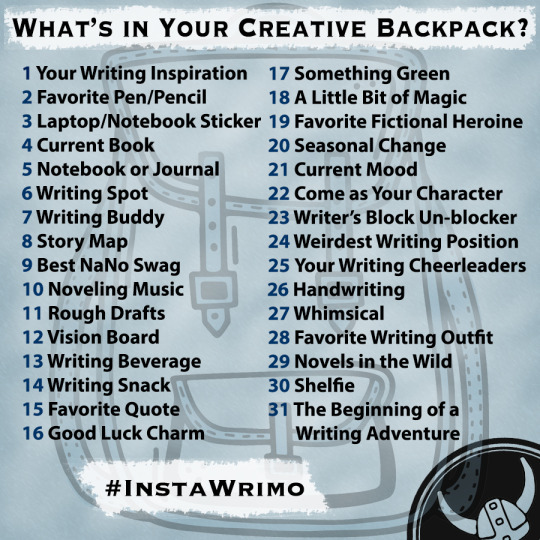
The month of March is almost upon us, which means that Camp NaNoWriMo will be here soon!
If you’ve never participated in Camp before, it’s an online writing retreat that we run every April and July. It’s kind of like November’s rebellious little sister: you can set your own goal, work on any kind of writing project (it doesn’t have to be a novel), and join a cabin to chat and write with other Wrimos.
This March, we’d like to get the awesome NaNoWriMo community excited about Camp by taking part in a month-long Instagram challenge hosted by us. All you need to join in is an Instagram account.
Follow @NaNoWriMo on Instagram.They say a picture is worth a thousand words (and you know we’re always keeping an eye on that word count), so we’ve come up with 31 photo prompts listed in the graphic above to get you thinking about your writing habits and the tools in your creative backpack for the month of March. We’ll post the full challenge prompt on Instagram, but it will also be available in this post if you need to refer back to it.
Much like Camp NaNoWriMo itself, there aren’t any strict rules. These prompts are just suggestions—you don’t have to be literal, though if you want to take these prompts very literally, that can result in some fun pictures, too. You can post a photo for each of the prompts, or choose just a few. You can post one every day, or all at once. Again, much like Camp, the most important part is having fun.
Make sure to tag any posts with the #InstaWrimo hashtag so we can find them! We’ll pick photos from the challenge to feature on our own Instagram account throughout the month. This will be a fun way to think about your writing projects and the tools you already have in your creative backpack: Where do you like to write? Who do you like to write with? What makes you happy about your writing?
Use your imagination, get creative, and get ready to write!
February 26, 2018
5 Ways NaNoEdMo Can Boost Your Writing Craft

February is wrapping up, but that doesn’t mean that you have to stop editing, pitching, or working on your writing project. In just a few days, we’ll be launching this year’s Camp NaNoWriMo, where you can keep working on your current story, or create a new one! But if you’re still deep in editing mode and want to discover more about the wider editing community, author Amber Michelle Cook is here to tell you about NaNoEdMo:
You did NaNoWriMo and have a novel! [*high five*] [*low five*] [*fist bump*] Now you’re looking for ways to craft that early draft into something even better. One of those ways is to do NaNoEdMo.
During National Novel Editing Month (held every year in March), writers participate in a challenge to spend 50 hours over the course of the 31 days of the month rewriting and editing your novel (or other writing project). An unaffiliated sister event to NaNoWriMo, NaNoEdMo has articles, forums, contests and winner goodies. And lots of camaraderie.
Any time you make a Big Push, doing a writing challenge like NaNoWriMo or an editing challenge like NaNoEdMo, you learn how much more you can accomplish than you ever thought possible. The benefits of this can be widespread over time, allowing you to take on more and new challenges with a higher degree of confidence and higher levels of expectation of yourself. But what about the specific benefits to your craft?
1. In theory…EdMo is all about editing, with new articles released each year, as well as forum posts and discussions, so you will learn in theory how to rewrite and self-edit your work better, faster, smarter. An increased understanding of what editing is will open your mind to new strategies and observations of your own work.
2. In Practice…Edmo is all about improving your existing draft by doing, so you will learn in practice how to rewrite and self-edit your work better, faster, smarter. You’ll be ready to edit future projects that much better and more efficiently from the start.
3. In Draft…As you incorporate what you’ve learned about rewriting and self-editing into your initial drafts or new chapters, they will be written at a higher level of craft to begin with!
4. In Concept…Once you start working on other projects in the future, you’ll have the history of your editing experiences in the back of your mind, and this means you’ll make more informed choices about the kinds of projects you embark on. Whatever kind of story you choose to begin will have a better chance of being strong, tight, and sale-able (or whatever your personal goals and targets are).
5. In Resource…When March is over and you soldier on with editing that project into shape, Edmo will have exposed you to a wide variety of resources on the subject, so that you can continue to learn and improve your editing skills over the coming year.
Like NaNoWriMo, EdMo isn’t always easy, but it’s always rewarding and productive.
You can sign up at www.nanoedmo.com. We look forward to seeing you in the forums!
Amber Michelle Cook is a speculative fiction author and the director of National Novel Editing Month, proudly living in ‘Keep Portland Weird’ Portland, OR. She’s a member of NIWA (the Northwest Independent Writers Association) and The People’s Ink writing community, with years of experience in writer’s critique groups. She did NaNoEdMo the first year it started, and every year thereafter, and loves it so much, she took over when the first director stepped down. Her author site: ambermichellecook.weebly.com
Top image licensed under Creative Commons from Colin Harris on Flickr.
February 23, 2018
5 Lessons in Measuring Your Success as an Author
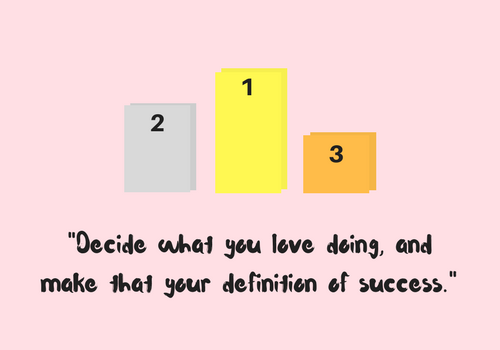
It’s easy to get discouraged when measuring your writing success against others’. How do you keep your dream afloat when it seems like everyone is ahead? Today, writer and publisher Nicolette Stephens shares five lessons she’s learned over the last few years:
In the two years I’ve been involved in publishing, I’ve learnt a lot about myself, publishing, and the human beings who inhabit the writing world (hint: they’re not that frightening). I jumped head first into the writing world with a lot of big ideas, and very little experience.
I’d like to share some of the lessons I would give myself if I had a time machine to go back to 2016:
1. You’ll never feel “ready” to pursue your dreams—you just need to go for it!Whatever your chosen career, it’s hard to build the courage to just “take the leap” regardless of the setbacks. Hard, but not impossible. There are a ton of successful people out there, and every single one of them will tell you that before they were successful, they were only dreamers.
What set them apart was that they did the work to become doers.
It’s easy and safe to settle into a comfortable relationship with your dreams—one in which there is no fear of failure. But at some point, success becomes a choice between working to make your dreams into the best reality they can be, or letting them remain ethereal.
2. Your success cannot be measured against someone else’s.There is a strange, yet popular belief that being a successful author/publisher means making a lot of money and becoming a household name. It’s easy to place authors like J.K. Rowling and Stephen King on a pedestal and compare one’s literary achievements to theirs—only to find them incomparable.
Nonetheless, I can almost guarantee that if you spoke to any of them (or their representatives), they would tell you they aren’t really sure what the magic formula is aside from consistent, hard work.
They’d also tell you that they just wanted to do what they love, every day, for the rest of their lives. Decide what you love doing, and make that your definition of success. Don’t allow anyone else to impose their beliefs of success on you.
3. Your vision will change and you will always want to know more.In the course of defining what “success” means to you, you may face doubt. You may come close to giving up, constantly question whether or not it’s worth it, and change your mind about what you truly want. This can come every day. Sometimes more than five times a day.
More often than not, you just need food. Sometimes, a good cry does wonders. Other times, you may need to take a break, gather some more info, and refine your vision.
No matter what the case, it’s okay to change your mind. But there’s one caveat: do so not because you’re scared or the work is hard, but because you have something new you want to add.
4. When necessary, defer to the experts.Let’s face it: we can’t be good at everything. Sometimes we finish writing our story, only to find we lack the energy, expertise, or perspective to edit it all by ourselves.
It can be difficult and costly to hire editors, cover designers, or marketers. But there’s a reason: expert help is expensive because people have invested their time and effort to become experienced at what they do, and that’s how they make a living.
It’s important to recognise what you can and cannot do yourself, and create a budget for the things that require expert assistance. It is also possible to find expert help without completely killing your budget.
5. You will create things you’re not 100% proud of.This is, perhaps, the hardest lesson to learn. As you grow and improve your craft, you will look back at your earlier creations, and probably wonder: what was I thinking?
This is good. It means you’ve learned and implemented lessons along the way. You’ve grown, both as an author and as a person.
Treasure those early creations because they, more than anything else, will become your personal measure of success. Own it!

Nicolette is the owner of Chasing Dreams Publishing. A one-woman outfit, she hopes to inspire, motivate, and guide authors to chase their dreams of telling stories. Chasing Dreams recently released Jozi Flash 2017, an anthology of 80 flash fiction stories by ten South African authors, across eight genres. It includes original artwork by Cape Town artist, Nico Venter, and is; in Nicolette’s view, the start of great things to come. She lives in Johannesburg with cats, dogs and a bird. Visit her website, Chasing Dreams Publishing, where you can download the Jozi Flash 2017 anthology, or follow her on Twitter @Rhapsody2312.
February 21, 2018
Follow The Rabbit: 3 Pro Tips to Get Your Story Traditionally Published

The path from plotless to published can feel like a journey into a rabbit hole: new, confusing, and even a little bizarre! Luckily, writer Shireen Hakim is here to share her pro tips for navigating the world of traditional publishing:
Turns out following a rabbit is a good idea.
After all, it led me to my first publication: “Rabbi the Rabbit,” which was my fiction short story published in the Houston Writers Guild (HWG) anthology Celebrating Diversity in April 2017. I created this children’s story after bonding with a rabbit in the forest, and then joined a critique group at an art gallery with a pet rabbit!
Although it seemed like fate, the journey included anxiety and anticipation. I pitched the story in October 2016, then eagerly waited until February to hear the results. I spent all of March further editing my story to meet the publication deadline. The comradery and discipline I gained from NaNoWriMo instilled in me the dedication and determination it took to get published.
If you want to get traditionally published, here’s what I recommend you do:
Tip #1: Write your story with abandon.Don’t write for a specific publisher—that will intimidate you and restrict your story. Let it come from your heart! I didn’t have any publisher in mind when I wrote “Rabbi the Rabbit,” so I was free to write it in my own style. This worked for me since I don’t like restrictions or confinement. Then, once the independent publisher HWG Press chose to publish my story, I learned what they were looking for and tweaked it to their parameters.
Tip #2: Get to know publishers for who they are, not what they can do for you.I was already Facebook friends with HWG’s Press Director, Andrea Barbosa, because I loved her optimistic posts and leadership qualities. We organically developed a professional writing relationship; I never pitched material to her. But since she knew my background and thought I could contribute, she notified me of the anthology publication contest and recommended I submit a piece. It’s not just about the people you know, but how you know them!
Tip #3: Accept and apply editors’ notes.Editing was the hardest part of the publishing process for me.
My other children’s story has been rejected multiple times, and I believe it’s because I ignored editing suggestions. For “Rabbi the Rabbit,” I went through two rounds of editing before my story was published. It is difficult to read a stranger’s critique of your words, but I understood that the editors wanted to make my work the best it could be. Their input furthered my opportunity to share my story with the world.
I took a few days to digest the suggested changes, and then applied them to maintain my voice. It helped that the editors emphasized that their suggestions were optional, and that it was up to me to accept those that preserved my vision. I’m grateful for the editing process because it taught me to ask myself honestly if my work was ready, or if I just wanted to be finished.
There is a right time for every story. When the world is ready to hear yours, it will be published. It’s like changing lanes on the freeway: you belong in the next lane—you just have to wait for the right car to let you in.
There is a space for your story; it’s just a matter of when. Writing your story sends a message the universe that you have a story that needs to be told. So write it. Don’t worry about where it will go.

Shireen Hakim is an award-winning children’s author and viral nutrition writer from Los Angeles, California. Her article is featured on the front page of the World Hijab Day website. Find her work on her Facebook page @WriterinaHeadscarf.
Top image licensed under Creative Commons from Joel Tonyan on Flickr.
February 19, 2018
Six Pro Tips for Year-Round Noveling
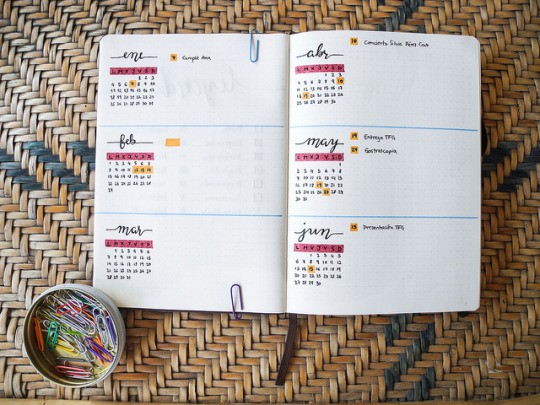
NaNoWriMo might only happen in November, but that shouldn’t stop you from working on your novel throughout the year. Today, writer, editor, and Municipal Liaison for the Europe :: England :: Cornwall region Anne Rainbow shares her tips for writing and editing your novel with precision:
1. Plan ahead.
I’m an ML for Cornwall, UK, and take part in NaNo every year. If you are a NaNo addict like me, it’s important that you plan how you will spend the months between one NaNo
and the next.
My
year is split into four phases. In
November, I write a new NaNo novel. It’s an indulgence, allowing
myself thirty days of writing to create something completely new. In
December and January, I relax! I reacquaint myself with family and
friends, and catch up on the day job. This creates distance between
me and the passion I felt while writing during November, which is very important for the stages ahead.
By
the beginning of February, I’m ready to start ‘working’ on a
novel. Maybe it’s the most recent—maybe it’ll be a novel from
an earlier year. The important thing is that I make a choice and focus on that novel. For the next six months, I make progress on that
novel.
But that all ends in September, because that’s when I
start planning my next NaNo novel. As you probably already know, this is a time to develop ideas, create outlines, flesh out characters, and make crucial
decisions as to the identity of my narrator(s) and when the story starts
and how it might end.
Then,
on November 1, I’m ready to begin again.
By the time November 30 rolls around, my novel is always incomplete. It’s a NaNo winner to be sure, as it’s
over 50,000 words, but it’s woefully short of however many words are needed to “finish” the story.
Before
I do any editing, I go back to my outline and compare the plan with the product I’ve written. I identify what’s missing—there are bound to be
additional scenes to write, so I tackle them first. Once
I’m happy it’s all there, I start the editing for real.
I then adopt my tried and tested “RedPen Editing” approach. I read
through the manuscript, making notes to myself on what needs my
attention. I create endless lists of tasks and then schedule them in
a systematic and sensible way, which minimizes the “overwhelm” from editing. When
I’m done with this first “tidy-up,” I’m ready to share my
novel.
I
belong to a local writers’ group called Ria View. Once a month, the six of us meet for a whole day. Some are working on novels; others are on short stories. There are even some memoirs! We submit up to 2000 words mid-month; I aim to prepare my
chapters, one or two at a time, for review.
We
then enjoy an hour in the spotlight, during which the other five
comment on our work. I leave that meeting with a pile of manuscripts
covered in comments and my head buzzing. I don’t act on the
feedback until all chapters have been through our editing process,
although I do take heed of their comments when finalizing later
chapters for submission.
Once
all the chapters of a novel have been through the review process, I
return to my RedPen Editing method. I work on all the comments and
complete the “drill down” stage.
I
make sure the manuscript really clean!
Before
I consider my book ready to ‘publish’ to the wider world, I ask a
team of beta readers for their feedback. Despite all the editing
effort put in to date, a beta reader, with a fresh pair of eyes, can
often spot something new for me to consider, or catch a discrepancy which
crept in during the editing stage.
I hope these tips will help you on your writing journey. Good luck, and see you for the next NaNo!

Anne Rainbow blogs on ScrivenerVirgin and hosts a free sixty-minute weekly webinar, encouraging writers to use Scrivener, the project management tool, taking authors from blank page to self-published book. As a RedPen mentor, Anne teaches editing techniques through online courses and series of live webinars. Her book EDITING The RedPen Way: 10 Steps to Successful Self-Editing explains her self-editing system. Anne leads the Ria View Writers group, and co-hosts the Wednesday Writers, the Hope Cove Weekend Workshops and the Writers@Watermill retreats. Visit her on Facebook and Amazon.
Top image is “Bullet Journal - Future Log” licensed under Creative Commons from Maria Garrido on Flickr.
February 16, 2018
I Wrote a Novel, Now What? Write, Rewrite, Publish, Repeat!

When it comes to editing, there’s no “one size fits all” approach. If you’re wondering how to get your NaNo novel polished for the presses, have no fear! Today’s post comes from Estonian participant and author Ene Sepp, who shares her advice for rethinking and revising your novel:
I found out about NaNoWriMo in 2013, and haven’t looked back since. Before then, I’d already published three books, but I wasn’t ready to call myself a “writer;” I still saw it as just a hobby rather than a career.
NaNo helped me to understand that I actually
could
call myself a
writer—and write a lot more than I first thought! Since 2013, three of my NaNo novels have been
published, and there is hope for the fourth one.
Of course,
getting from a draft to a hard copy doesn’t happen in an instant. Sending out your very first NaNo draft as is won’t get you a publishing contract—if you’re lucky, you’ll get some very polite rejection letters. No publisher
wants to dig through a story with tons of
grammatical errors but no logic.
For me, the second draft is as important as the first. This is the only
way I can actually make my story good enough to share with other
people.
The very first
thing I actually do is print my story out. It may seem like a waste of
paper, but for me it’s become an essential part of my writing
process. I print the story and, scene by scene, cut it to pieces. After
I have a pile of scenes, I place them on my living room floor
(praying there is no gust of wind), rearranging if needed.
I absolutely hate
scrolling up and down in Word, to find a more suitable place for some
lonely scene. Although I’ve moved on to Scrivener, playing
around with my scenes on the floor makes it a lot easier—and fun! When I am
happy with the new layout, I just retype everything. It takes a good
amount of time, but I can already clear out some grammatical errors
and make sure that everything is in order and sounds logical.
I highlight
scenes that need some fact checking. I try to do it while writing,
but if I can’t then it’s better late than never. This is also the
time where I think about potential beta readers. I start the search early so that when my story gets to the beta-reading-phase,
I can just send it on its way.
For example, my
latest book, I wrote about horses and riding—so I got in touch with
teenagers who ride in order to make sure I got my story right. In my fifth book, my main character had to deal
with her mom coming out of the closet, so I found people from the
LGBT community who could read the story and let me know if everything
was realistic. For my fourth book, I needed details about how a huge
lottery win is handled. I gathered up my courage and sent an e-mail
to the company that is responsible for lotteries—lo and behold, the answer I got was
very thorough, and so it found its way into the final version. Sometimes all you have to do is ask!
Every editing session gives me the idea how I want to write my next book.
After NaNo 2016, when my story was a huge mess (I’ve since found I cannot be a pantser) and I spent way too much time making it readable, I promised that I would start to put more effort toward making the editing process smoother!
And then… after
re-reading and rewriting the story, I can send it off to the publisher
and hope they are actually interested in publishing the novel I
worked so hard on.

Young adult author Ene Sepp started writing her first book when she was 14 years old and it was published couple of years later. By now, at age 26, she has published 6 books that have been very well received by the readers. She is published in Estonian but as she spends part of the year in New Zealand and USA. Ene is preparing to get her work translated and to start writing in English. Visit her online on Instagram, Facebook, and Goodreads.
Top photo licensed under Creative Commons from Mike Pratt on Flickr.
February 14, 2018
Chasing Unicorns: Publishing Tips from a Pro Who’s Seen It All
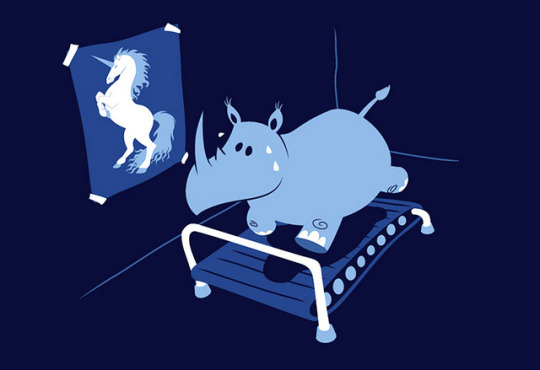
So you’ve written your novel, put it through countless rounds of editing, and are ready to publish. But where do you start? And how do you choose which path to follow? Today, author Silver James shares her tips for how to take your novel from polished to published:
Once upon a time, a novelist hunted an elusive unicorn named Agent. The novelist hoped that capturing such a rare creature would send them to the end of the rainbow and the pot of gold known as A Publishing Contract™. That amalgamated fairy tale is still the goal of some—but not all.
In today’s publishing culture, there are a few paths a novelist can follow: traditional publishing—with a fork leading to small presses or big publishers; and self-publishing. A writer can choose one or all, depending on personal goals.
No longer does a novelist have to be “electric” or “gasoline” in order to publish. We can be hybrids now.
I’m a hybrid. I first published with a small press in 2008. Four years later, I jumped off the cliff to swim in the rip tide of self-publishing, all the while hoping to sign a contract with a New York publisher. I signed my first contract with Harlequin in 2014. Since I began, I’ve had 41 books and novellas published, as well as learned how to juggle contracted deadlines with the desires of the fans of my self-published series.
So you’ve won NaNoWriMo. You’ve started editing your manuscript. Maybe you’ve polished it to a shiny finish. But what next? The blunt answer: It depends.
“On what?” you ask. “On you,” I answer. Your publishing destiny depends on your expectations, your career path, and your knowledge and ability. No path to publishing is easy; they all take work and at least one takes extra expertise, and there are pros and cons to each.
Traditional PublishersAlthough the “traditional” publishing industry still has “gatekeepers” in the form of agents, many publishers are open to un-agented manuscripts. Some have even created newbie-friendly “digital-first” lines. It’s a slow process, and you need to know the market for your genre; you need to have something the publishing house thinks they can sell; and most importantly, you need to have patience. Most authors will not have a “golden fleece” manuscript that goes to auction for six or seven figures—though you will get an advance, which makes the wait a little easier.
Small PressesSmall presses are sometimes more open to new talent. They lean toward niche markets and may provide digital-first options. Sometimes they offer advances. They provide editors, cover art, and the physical publishing. They may even do some marketing for you. An advantage of small press is that you learn the process of publishing, from final draft to revisions letters, to editing and copyediting, proofreading, and final publication. There’s more steps than you’d think!
Self-PublishingSelf-publishing may seem like the easiest path. Write the book, upload it, make money, right? Take it from me, it’s not. If you just want to write books, go after a traditional contract. Self-publishing is a business and you are the CEO. You’re in charge of editing, covers, formatting, uploading, all the paperwork, and marketing—all of which takes perseverance, expertise, and a head for business. It’s not easy, but it’s worth it.
The number one piece of advice I give to a new writer? Work with an editor. Every writer needs an editor—no ifs, ands, or buts! If you sign with a publisher, you will work with an editor. If you self-publish, you’ll need to find your own, but your readers will thank you! (Okay, climbing off my soap box now.)
I do love a good cliché (but avoid them in my books because editors), but I’ll say it anyway: I hope I didn’t rain on any parades. Take it from me—the path to publishing takes a lot of work, but if your dream is to be published, you can do what it takes to make it come true. I did, and I’ve never looked back.

Silver James likes walking on the wild side, and coffee. Okay. She loves coffee. LOTS of coffee. Warning: Her Muse, Iffy, runs with scissors. An award-winning author, she’s worked with the military and in the legal field, fire service, and law enforcement. Now retired from the “real world,” she spends her days with two Newfoundland dogs and the cat who rules them all, writing paranormal suspense, urban fantasy, and sexy contemporary romance for Harlequin Desire. Look for Silver online at her website, buy her books on Amazon, follow her on Twitter, Facebook, or Pinterest, or sign up for her newsletter.
Top image licensed under Creative Commons from Brett Jordan on Flickr.
February 12, 2018
Fantastic Agents & Where to Find Them
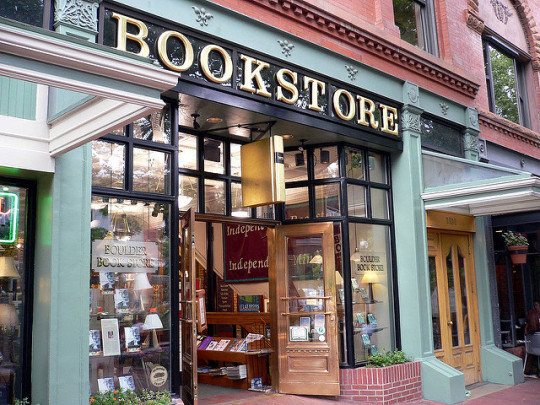
So you have your NaNo novel in hand, and you feel ready to publish. But before your book makes it to shelves, it has to change hands—from writer to agent to editor and publisher! Today, author, ML, and seventeen-time NaNo participant Lauren Karcz shares her advice on how to track down the elusive agent:
So you’re almost done revising your NaNoWriMo manuscript. Or maybe you’ve already finished and prepared a submission package. Perhaps you’re meandering around the NaNo forums, Twitter, or other haunts for writers, catching bits and pieces about the traditional publishing process and wondering how to get started. A huge, but often overlooked part of the writing process is finding a literary agent—which can be challenging for first-time writers!
To the untrained eye, agents appear to be wily creatures, making magic for authors’ careers but often keeping a low profile themselves. As someone who took a weird joy in demystifying the publishing world for myself, let me help you on the path to researching literary agents and finding a good match for you.
What does a literary agent do?A new writer’s primary reason for seeking an agent is one of access—simply put, agents have connections to editors at major publishing houses. And when I say “connections,” that’s not just a matter of having their email addresses and phone numbers. It’s that they know editors’ tastes inside and out: what has an editor recently bought, and what are they looking for right now? When an agent sends out a manuscript on submission, the manuscript usually goes to more than one editor at a time—specifically, those who the agent thinks will be most interested in it.
An agent isn’t a guaranteed ticket to a book deal—let alone a quick book deal—but they should be a person in your corner who wants both of those things to happen as much as you do.
As you get further into your writing career, an agent becomes a vital person to have for the “business” side of the book business. Contract changes, foreign rights deals, audio rights deals, multi-book deals, marketing plans, changes in your publishing team—you name it, a good agency should have experience with all of these aspects of the business, allowing you as the writer more time to work on your next book.
On the “Now What?” NaNoWriMo forums, I’ve seen some writers mixing up the jobs of agent and publicist. An agent can’t really do anything with a novel you’ve already self-published, or even published with a small press. If you’re looking for someone to help you sell an existing published book, seek out a publicist instead of an agent. If the issue is that your book has been out a few months and isn’t selling as well as you’d hoped, a publicist is unlikely to take you on, either. Your best bet at that point is to write a new manuscript.
OK, so I definitely want to get an agent! Now where do I find one?Well…do you like research? Do you like research that’s kind of twisty and turny and never entirely done? Great! You’ll love finding out about the publishing industry. Writers have sometimes asked me for a “list of agents to submit to,” which isn’t quite a thing that exists, and if it was, it wouldn’t be the same list for each writer.
The closest thing you’ll get to a “list of agents” is QueryTracker, a fabulous site with lots of tools for creating your own query list, including finding agents for your particular genre. But before finalizing your list, you’ll want to conduct your own research. Who represents books that are like yours? You’ll find that info either on an author’s website, or in their book acknowledgments. Wind your way through agency websites and look at individual agents’ wishlists. You might find these on an agent or agency’s Publishers Marketplace page, as well (this link to my agency’s page provides a good snapshot of who’s at the agency and what they’re looking for).
Google the agents you’re interested in; hopefully, you’ll find interviews or blog posts they’ve done over the years. You’ll start to get a sense of their personalities. Perhaps you’ll get starry-eyed over one or two “dream agents” who seem like the best possible fit for your career. That’s normal, but don’t get so hung up on one person that you neglect to query widely.
Don’t restrict yourself to only one type of agent, either—for example, only brand-new agents, or only agents who represent bestsellers. It’s possible that the agent who best understands your manuscript isn’t the one at the top of your list. You never know until you find out!
It’s easy to get caught up in all of this research, though (speaking as someone who did)! Don’t get too obsessed with it. At some point, you need to cut off the “looking for agents” process and start querying the agents you think might be a good fit.
A few quick cautions:Don’t pay any agent upfront. They should get paid when you get paid—that is, they’ll take a commission after your manuscript sells.Some authors prefer to have an agent based in a big city like New York or London. But there are many fantastic agents who live elsewhere! As long as they have the right connections, an agent can work from anywhere.
Some agents, like many writers, have second jobs. They may be an assistant to a senior agent, or a bookseller. Some agents are authors themselves. Don’t let an agent’s other ventures necessarily disqualify them from your consideration. But do be wary if they have a lot of side hustles that take significant time and energy away from their agenting.
Researching someone who’s new to agenting? Look into where they’ve worked before. If they’re coming to agenting from the editorial or sales side of book publishing, they probably have what it takes to make it as an agent, too. If the person has no experience in the book world, you’ll need to get concrete information as to whether the agent has the connections to sell a book, and the knowledge to negotiate a contract.
Good luck!

Lauren Karcz is the author of the YA novel THE GALLERY OF UNFINISHED GIRLS (HarperTeen, 2017). She’s also a seventeen-time NaNo participant and former ML of the Atlanta region. Find her on Twitter or Instagram, or at www.laurenkarcz.com.
Top image licensed under Creative Commons from Michelle W on Flickr.
February 9, 2018
What NaNoWriMo Gave Me as an Author—and a Person

The road from plotless to polished to published can be long and filled with potholes (and plot holes). But, as NaNo participants continue to prove, it can be traversed. Today, author Christa Avampato shares her story of how she turned an outline into a published book:
In the five years after I
survived an apartment building fire on the Upper West Side of
Manhattan, I sketched the outline of my novel, Emerson Page and Where the Light Enters. That fire was a turning point for me, as a person and as a
writer. It also plays a prominent role in Emerson’s story.
On November 1, 2014,
I set a goal to transform my outline into a 50,000-word first draft
in thirty days as part of NaNoWriMo. It seemed impossible, but I was
constantly encouraged by the supports that NaNoWriMo offers:
webinars, blog posts by authors I admired, writing prompts, social
messages, and special offers for books and tools.
My first draft was
terrible, but I’ve never been prouder of something so awful.
Over the next two
years, I completed a dozen more drafts of Emerson’s story. New
characters, plot lines, and settings emerged. Save for Emerson, the
story was almost unrecognizable two years later. I got
feedback from several close and brutally honest friends. I agonized
over every word. It is the toughest job I ever loved.
Still, Emerson
continued her incessant tap, tap, tapping on my shoulder because it
was time to get her story published. I queried agents, and received
fourteen rejections—and those were just the ones who bothered to respond
at all! One of them, my dream agent, responded with the loveliest
rejection. Twelve were form letters. One particularly prickly agent
responded in less than five minutes with a one word email: No.
I’m
not kidding. That actually happened.
I finally found a happy medium when I
began to explore independent publishers. Six months after querying my
first independent publisher, one of them accepted the book.
When
you launch a book, you launch a brand and a business. I completed
several full edits in 2017 with the assistance of two editors. Then I
hired the artists and art directed the cover art myself. With my MBA
and business experience, I put together a marketing plan, and began
to work that plan every day.
On November 1, 2017,
I became a published author. Emerson left the safety of my care and
ventured out into the world wrapped in paperback and eBook formats on
Amazon, Barnes & Noble, and in independent bookstores across the
globe. It’s no coincidence that Emerson’s birthday was exactly
three years after I started writing the draft of her story during
NaNoWriMo 2014.
And on her birthday, I began writing the draft of her
second book as part of NaNoWriMo 2017. That supportive tribe of
fearless writers with impossible goals was there for me again, just
as they were in 2014.
Emerson
and I stand before you as an unfailing reminder that if you are
willing to do the hard work of recognizing your wounds, if you write
your truth through programs like NaNoWriMo, even if your voice shakes
and sputters, if you will honor the cracks in you rather than trying
to spackle them shut, there is so much light that awaits you.
That’s the greatest lesson that NaNoWriMo and Emerson taught me: that
light will flood your mind, heart, and hands in a way that you never
imagined possible. That light, however small, lives in you now. Your
only job is to fan it into a flame that the whole world can see
through the masterpiece that is your life and your writing. You
matter. Your story matters. It matters so damn much.
I can’t wait to read
your book.

Christa
Avampato is
an author, journalist, and business leader in New York City. She
began her career managing Broadway shows, and now works with
performing arts organizations and museums to help them use technology
to grow their audiences. She's been
an invited speaker on the power of the imagination at SXSW and Games
for Change.
Her writing has been featured in The
Washington Post,
Royal Media Partners magazines, PBS.org, HuffPost, Megyn
Kelly TODAY, and Cheddar. Dedicated
to helping young people find their own voices, she’s worked
with 826national.org, Sesame Workshop, New York Public
Library, University of Pennsylvania (her alma mater), and Cornell
Tech. Christa
earned her MBA at the Darden School at the University of Virginia.
Find her on Twitter
@christanyc, Instagram
@christarosenyc,
and christaavampato.com. Her
young adult novel, Emerson
Page and Where the Light Enters,
is available online and in bookstores worldwide.
Top image licensed under Creative Commons from Jon Seidman on Flickr.
Chris Baty's Blog
- Chris Baty's profile
- 63 followers



